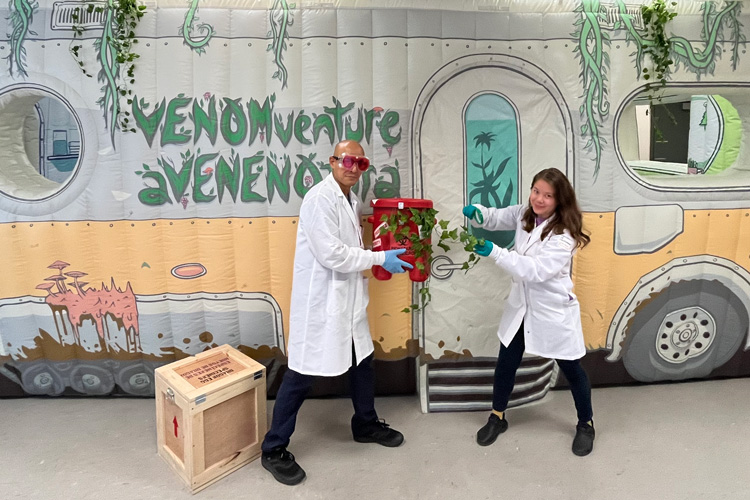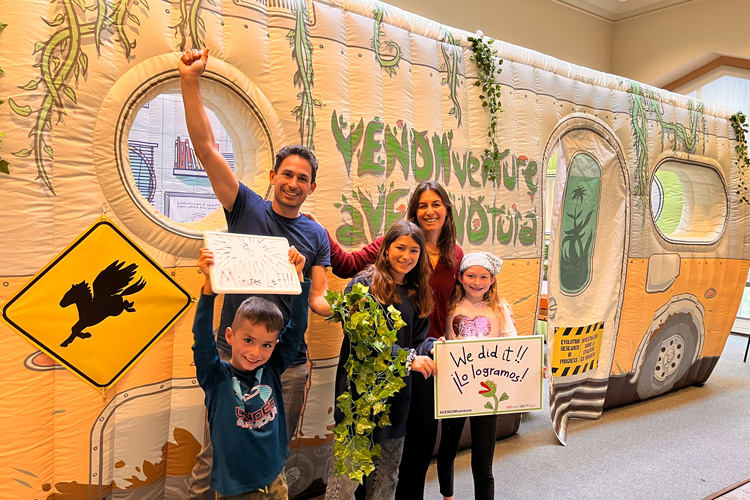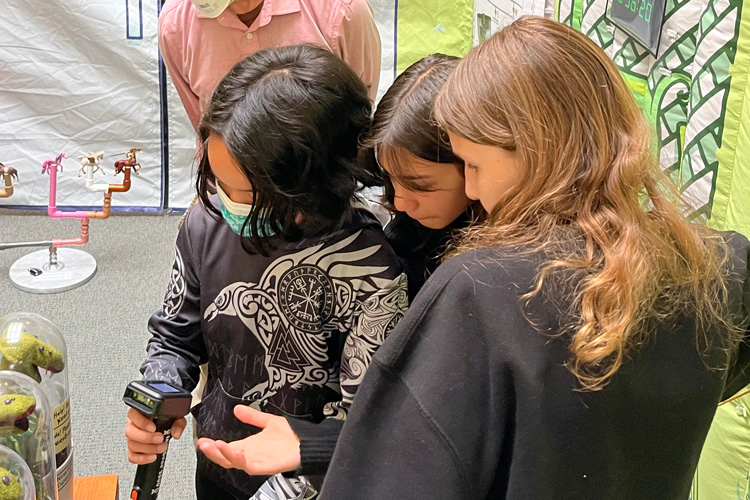An escape room for families teaches fundamentals of evolution
Can you create an antivenom in time to stop a green plague from taking over the world? VENOMventure - aVENENOtura is a fun game for any family, thanks to UCMP.
June 23, 2023

UC Berkeley graduate students José Adan Arevalo and Emily Lam outside the inflatable escape room that is traveling to museums and libraries around the country to provide a fun way for families to learn about biology and evolution. Arevalo voiced some of the Spanish-language audio used in the game. (Photo credit: Anna Thanukos)
A strange and mysterious plant is on the rampage, causing people to break out in itchy purple blotches!
The premise of a new sci-fi movie or dystopian video game?
No, it’s the theme of a new escape room — an immersive educational adventure that families emerge from only after solving science puzzles to save the world from a prickly end. The game takes place in an inflatable space about the size of a small bus, decorated to look like a mobile lab and labeled VENOMventure — or aVENENOtura, in Spanish, since the exhibit is bilingual.
Created by educators at the University of California Museum of Paleontology (UCMP) at the University of California, Berkeley, and the University of Kansas Biodiversity Institute and Natural History Museum in Lawrence, VENOMVenture premiered in its final form over the last two weeks at the Berkeley Public Library, drawing rave reviews from one elementary-schooler and a thumbs-up from some 60 families that, thankfully, escaped without succumbing to the plant plague.
“The escape room was so much fun,” 8-year-old Mizuki wrote in a letter to the children’s librarian the day after her adventure. “Thanks for letting me try the escape room before it started.”
To quote more of Mizuki’s fan mail would give away the new game’s clues.
“There are a lot of educational games, and even a few educational escape rooms at museums, but this sort of immersive, physical game is unique in terms of the nature of the learning goals that we have for the room — to improve public understanding of basic concepts in biology, particularly related to evolution and evolutionary relationships,” said one of the developers, Anna Thanukos of UCMP. “This is something new that’s never been done before. So we’re interested in learning what we can about how people do or do not learn in these particular environments.”
It’s designed to delight
The escape room adventure was developed with roughly $1 million from the National Institutes of Health through their Science Education Partnership Award. A key part of the five-year project is to assess, through follow-up with families, how well such STEM-based immersive experiences convey biological and scientific concepts, and also to direct kids — in this case, those between 8 and 14 years of age — to careers in the biomedical sciences.

The Weintraub family celebrating after successfully exiting the escape room at the Berkeley Public Library. Jeremy and Miranda Ritterman Weintraub with their children, (left to right) Lev, Amiela and Chana. (Photo credit: Anna Thanukos)
“One of our goals is for families to have productive conversations with each other about science and problem-solving, and increase awareness of biomedical careers,” Thanukos said. “We want this escape room to be a high engagement and very memorable and positive experience for families.”
An accompanying comic book, with puzzles, stickers and cutouts, encourages ongoing discussion.
“Our aim is that the learning doesn’t stop with the game, but that the game instigates a continuing interest in these topics,” she said.
Emma Coleman, a librarian at the Berkeley Public Library, is enthusiastic about VENOMventure, noting that the library’s patrons “eagerly signed up for an opportunity to crack the evolutionary codes and save the world,” she said.
“The escape room was meticulously and ingeniously crafted and provides a satisfying experience for children age 8 to 14 and their adults,” she said. “It was booked solid, and we hope that someday it will return to the Berkeley Public Library.”
Inside the inflatable mobile lab, which can be broken down and shipped to other museums and libraries, are specially designed props and prompts to help families figure out a way to create an antivenom to stop the venomous plant in its tracks. This involves an understanding of how life evolves, analogous to the way the COVID-19 virus evolved over the past three years. But this fictional scenario is not as scary, Thanukos said.
“It’s cute. It’s designed to delight,” she said.

Left to right, Philip Roopnarine, Kiri Marshall and Kira Street explore some of the props as they try to create an antivenom to thwart a killer plant and unlock the door of the escape room. (Photo credit: Anna Thanukos)
Both she and co-developer Teresa MacDonald of the University of Kansas enjoy adult-oriented escape rooms, an interest that inspired VENOMventure. The two worked closely with Lisa White, assistant director for education and outreach at UCMP, and museum and library personnel.
The public’s next opportunity to experience the game and to participate in the project’s research agenda will be at the Modesto branch of the Stanislaus County Library, June 22 through June 29. VENOMventure heads to the California Academy of Sciences in San Francisco for a one-week run July 9 through 13. The Cal Academy is one of UCMP’s collaborators on the project.
Thanukos noted that the escape room aims to reach rural libraries, where science educational options are few, but that during the current testing phase, it’s visiting libraries near science museums. Later this summer, it will visit the University of Kansas, after which it will travel to the Arizona Science Center in Phoenix, New Mexico’s Museum of Natural History and Science in Albuquerque, University of Iowa Museum of Natural History in Iowa City and Yale Peabody Museum of Natural History in New Haven, Connecticut.
“I would say that for 90% of the people who are going through this room, they’ve never done an escape room before, and the things that happen in the room really surprise and delight them. They don’t expect that to be how it works. They don’t expect that sort of puzzle,” she said. “That has been really fun to observe and listen to as families work their way through the room.”
In addition to the enthusiastic response of kids and families, Thanukos said, librarians seem eager to offer the experience for their young visitors.
“The librarians seem to feel like it’s worth it. They’re very excited. They are eager to get more people to do it. They keep bringing new librarians in to see it and try it out,” she said. “It’s been really fun to see them excited about this project. And I’d say it’s a good sign for the reception it gets at other institutions.”
RELATED INFORMATION